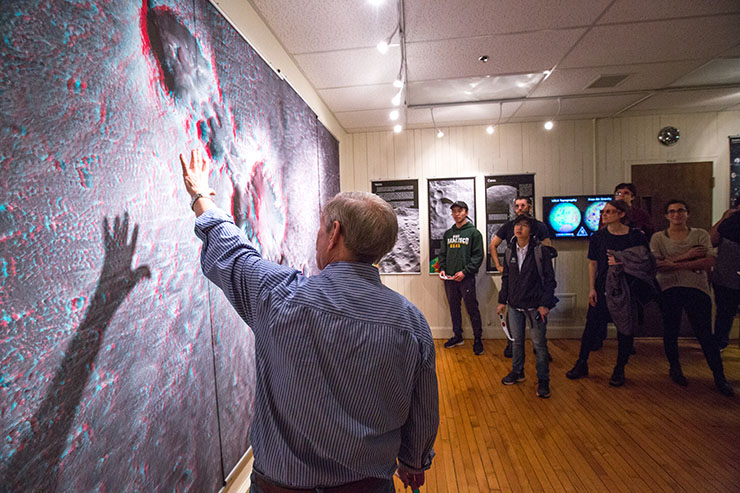
Planetary Geologist Peter Schultz talks to first-year D+M students about the importance of visual evidence for scientific research at the Northeast Planetary Data Center. | photo by Jo Sittenfeld MFA 08 PH.
As a group of Digital + Media grad students gazes through 3D glasses at a wall-sized image of a Martian crater, planetary geologist Peter Schultz is eager to provide a rare perspective about the importance of art, design and visual communication to the sciences. “When I was on a mission to a comet,” says the director of the Northeast Planetary Data Center (PDC), “we flew by it and everyone rushed to print out large images so that we could make observations together.” During a presentation at the NASA/Brown University research facility, he pointed out how practitioners in his field rely very much on imagery and visual evidence to pursue their research.
The late September visit to the PDC is one way first-year students in a D+M graduate studio/seminar are introduced to research-based studio practices. “We work with a very rich definition of research,” says D+M faculty member Aly Ogasian MFA 15 DM. “Research can take place in a library, or an academic institution, or in the studio or a laboratory. This is something we really push D+M students to think about.” A recent graduate of the program herself, she has a strong interest in astronomy and photographs of space exploration, and finds the PDC to be an ideal site for students to consider similarities between artistic and scientific inquiry – in terms of both processes and outcomes.
“It’s about presenting what’s possible,” Ogasian continues. “We want our students to make real-world connections, either through research or through collaborations with people in other fields, or simply by finding inspiration in unexpected places.” At the PDC, one of eight facilities of its kind in the US, Schultz dug into a rich archive of both analog and digital research from NASA missions like Deep Impact and the LCROSS expedition, which sought to detect the presence of frozen water beneath the surface in a shadowed lunar crater near the south pole. He also shared 6,000 frames-per-second video evidence from his volcanic ballistics research at NASA’s Ames Vertical Gun Range in California, a facility that allows him to study planetary-scale phenomena in a small space and then extrapolate the results.

